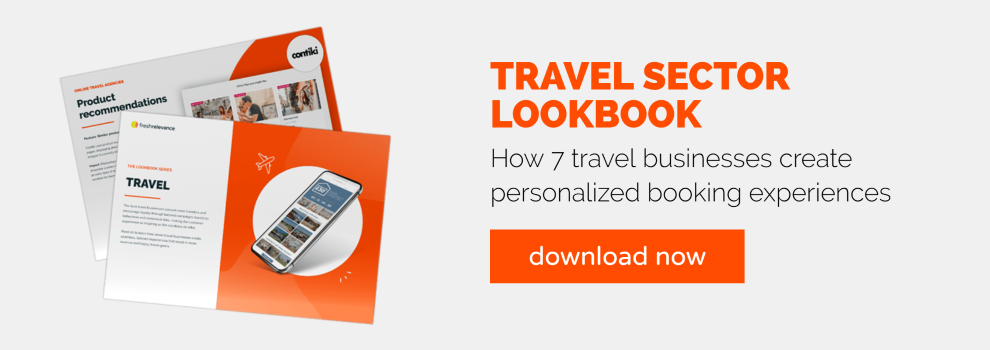It is well documented that we are now a nation in search of instant gratification. From our boxset bingeing habits and same day delivery options, to the rise of dating apps and nagging frustration if a webpage doesn’t load within a second; in many aspects of life patience has been replaced by the need for speed. Yet, despite the pressure for immediacy, booking a holiday appears to be the exception to the rule; nearly half of holidaymakers spend longer researching a trip than the duration of the holiday itself.
There is pleasure gained from poring over idyllic imagery of castaway beaches, iconic landmarks, exotic dishes and exciting experiences as part of holiday inspiration, but in a world where we demand rapidity so often, does the lengthy research process actually indicate a disconnect between travel providers and consumers?
With so many ways to plan, compare and create a trip that’s just right for individual prospective customers, holidaymakers are spoilt for choice, but with choice comes indecision. For marketers in the travel and tourism sector, the focus should not only be on inspiring consumers, but beyond that: giving them the confidence to book. With this in mind, we have outlined some of the key tactics that those in travel companies should consider to help drive greater engagement, reduce the research time and ultimately increase bookings.
The Power of Social Proof
With cost often a big factor when booking travel, consumers want to feel confident that the hotel, cruise or package they are spending money on is right for them. According to our study, 42% of holidaymakers are using review websites like TripAdvisor as part of their holiday research, indicating the influential role that social proof holds. Here are some social proof tactics to implement.
Ratings and Reviews
You can display customer reviews throughout each stage of a customer journey, as it builds trust and authenticity around the brand. Without social proof tactics, even the most visually appealing hotel or resort is going to have a significantly harder task to give a consumer the confidence to part with their money.
In the example below, travel business Six Star Cruises makes use of star ratings and reviews on their homepage and product pages, easing purchase anxiety and increasing the likelihood of direct bookings.
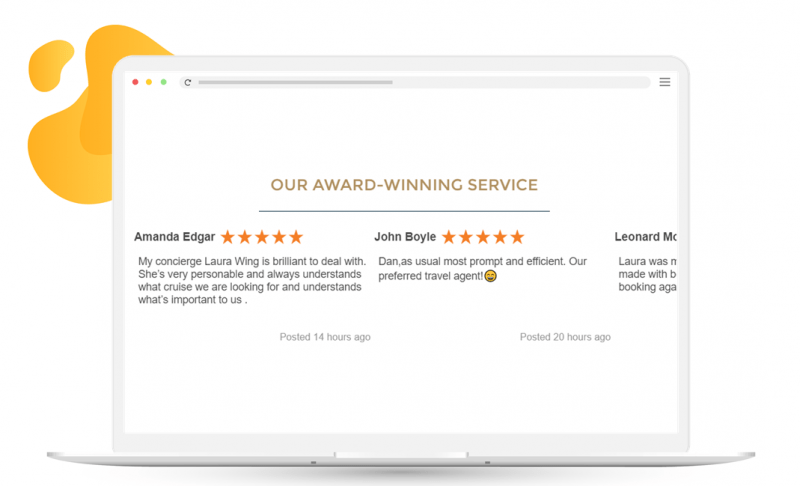
Source: sixstarcruises.co.uk
User-generated content
Another social proof marketing tactic travel brands can use is leveraging user-generated content (UGC). Encourage previous customers to post photos and videos of their holidays booked with you on social media sites and adding specific hashtags and/or tagging you in those posts. UGC also helps inject more personality into a brand and often gives more details. This helps consumers to quickly identify what’s right for them, driving them to the final stage of booking sooner.
Our own research found that 29% of millennials use visual social media platforms like Instagram and Pinterest to research their holidays. With more user-generated content available for places within the UK, pulling customer photos and posts in real-time from the social network directly into web pages and emails can add a layer of authenticity and promote popular or niche destinations.
Travel company Trafalgar does this in their emails in the example below, showing a positive travel experience in each post.
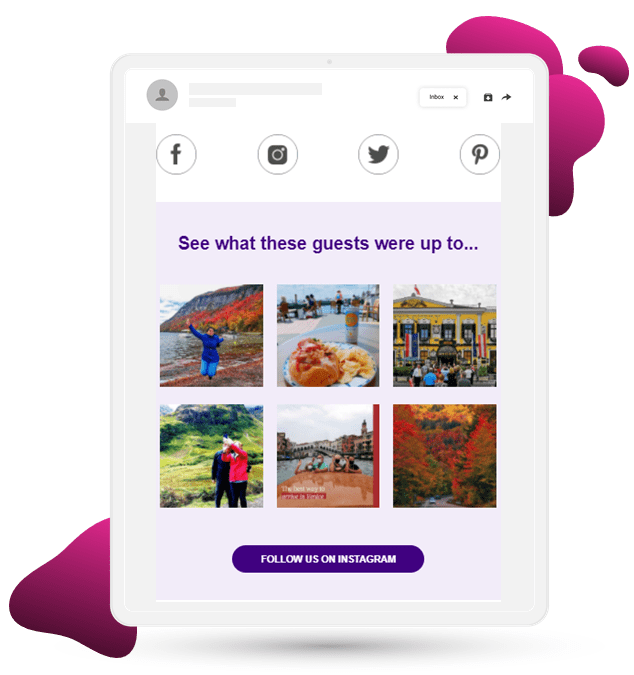
Source: Trafalgar email
Popularity and scarcity messaging
Another major travel marketing tactic the travel and tourism industry can make use of is popularity messaging. By recommending trips that are both popular and relevant to the customer based on their behavioral data, you are more likely to encourage customers to book. This is due to FOMO (the fear of missing out) and the wisdom of the crowd.
Travel marketing company Six Star Cruises makes use of this tactic in the example below, giving travelers the inspiration they need to book

Source: sixstarcruises.co.uk
Scarcity messaging is also a useful travel marketing tactic that creates urgency to speed up purchase decisions. In the example by travel brand Sunwing pictured below, the company shows how many other prospective customers are browsing the same hotel.
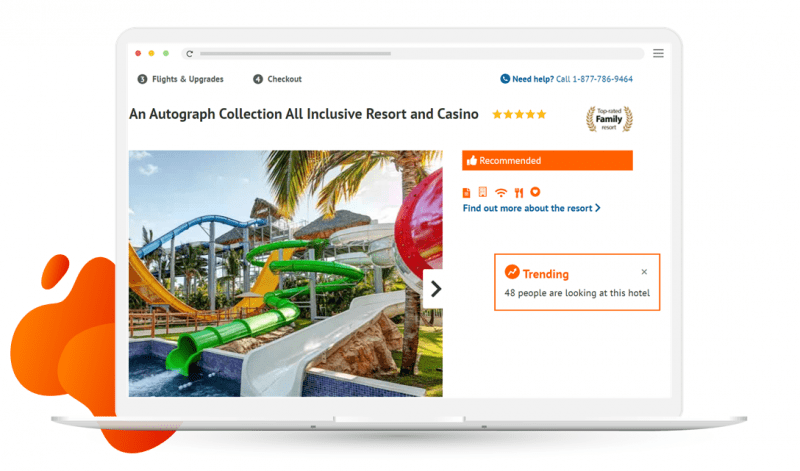
Source: sunwing.ca
Remind customers to come back and book
Companies within the travel industry can make effective use of triggered emails, such as the ones mentioned in the examples below. Not only that, but travel marketing strategies can look at social media to re-target individuals.
Cart and browse abandonment
By using the customer’s browsing data to inform which marketing messages and offers to show each shopper, travel companies will stay front of mind, and most importantly nudge shoppers towards conversion. Triggered emails around the resorts or packages they’ve browsed previously, or recommending similar options they might like, are effective ways to encourage a consumer to reconsider a booking.
In this example, Destin Florida sends cart abandonment emails to customers who started a booking but never finished. The email includes details of the carted accommodation, making it easy and convenient for the customer to finish their booking.
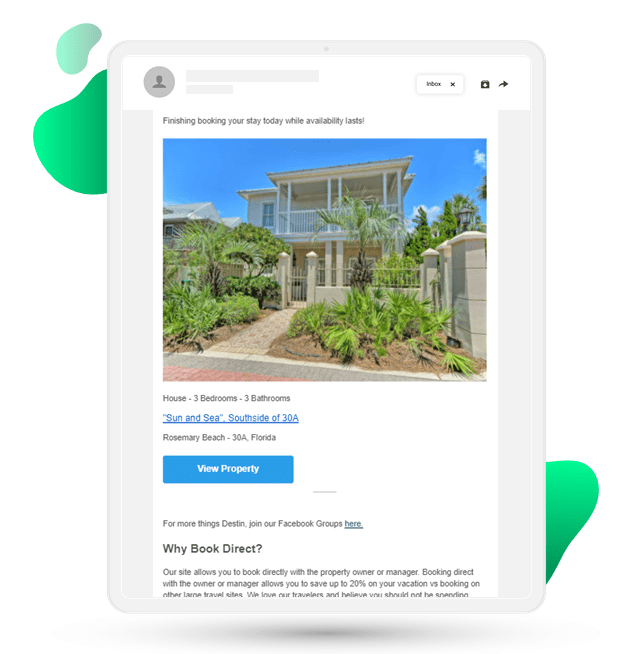
Source: Destin Florida email
Visual reminders
With one in three Millennials seeking holiday inspiration on social platforms, travel brands can display retargeting ads on social media to remind the consumer of the deals and vacations they abandoned. A website popover displaying the holiday a returning visitor viewed during their last visit will make it easy for them to continue where they left off.
Cottages.com uses a popover when customers return to their website, encouraging them to continue where they left off.

Source: cottages.com
Price drop emails
Alternatively, making shoppers aware that a hotel or package they browsed has dropped in price through price drop emails could be the nudge a browser requires to make a booking. Using dynamic content will ensure email and web content is always up to date at the moment of engagement, so consumers aren’t left disappointed by an offer that’s expired or is no longer available.
Provide helpful information to reduce bounce rate
Most consumers looking to book trips overseas do this in the hope of being able to experience some sunshine or an exotic location. Clarity and guidance at every stage of the customer journey is key for building trust and encouraging bookings.
For example, you could add cancellation policies to your homepage, which your customer can immediately view. This ensures that the customer doesn’t need to go through your search feature for information on what will happen if their holiday is affected by cancellations, or what would happen if they had to cancel.
Final thoughts
Whilst consumers undoubtedly enjoy taking time away from the day-to-day to scroll through picturesque images and be inspired by the prospect of a trip away, it’s in both the consumer and marketers’ favor to reduce lengthy decision making. There are now many opportunities to provide excitement while building consumer confidence and encouraging them to make a booking. The travel industry brands that can do this again and again will receive the ultimate reward of a loyal customer base.
Travel brands strive to recover and thrive in a post-pandemic world, launching a confident travel initiative can be a crucial strategy. By prioritizing transparency, such as clear health and safety protocols, cancellation guarantees, and real-time updates on travel requirements, companies can significantly gain customer confidence. Providing accessible, up-to-date information reassures travelers and helps reduce hesitation during the booking process. When consumers feel supported and informed, they are far more likely to commit—turning uncertainty into action and browsers into loyal customers.



